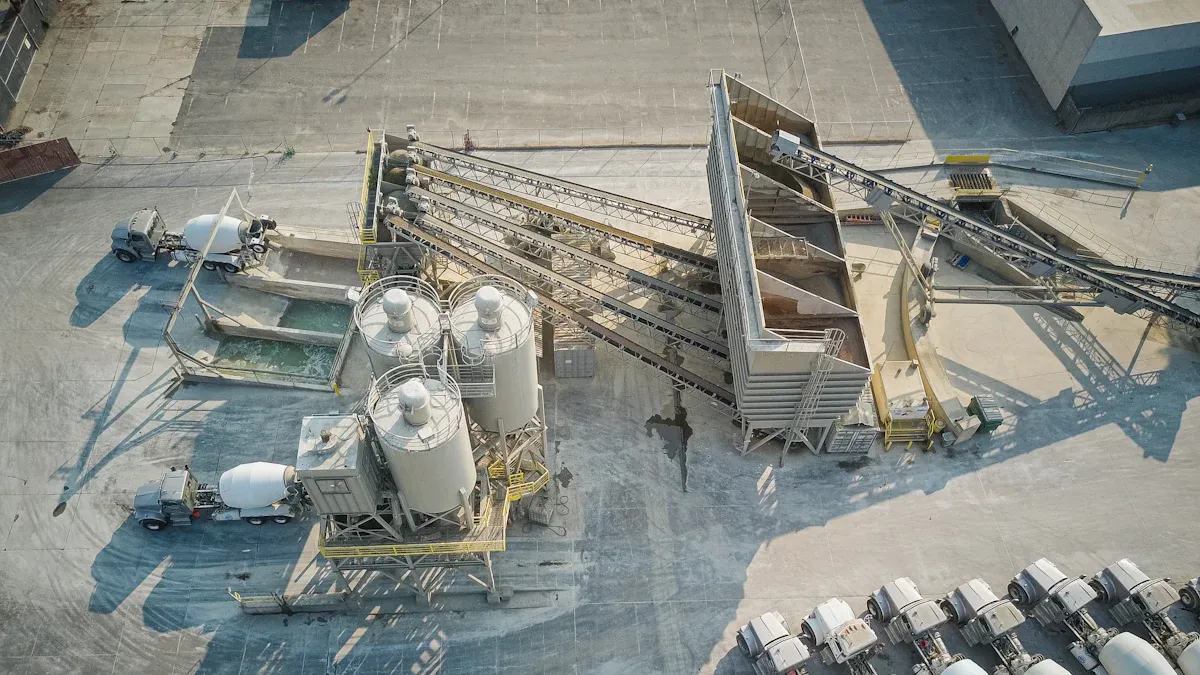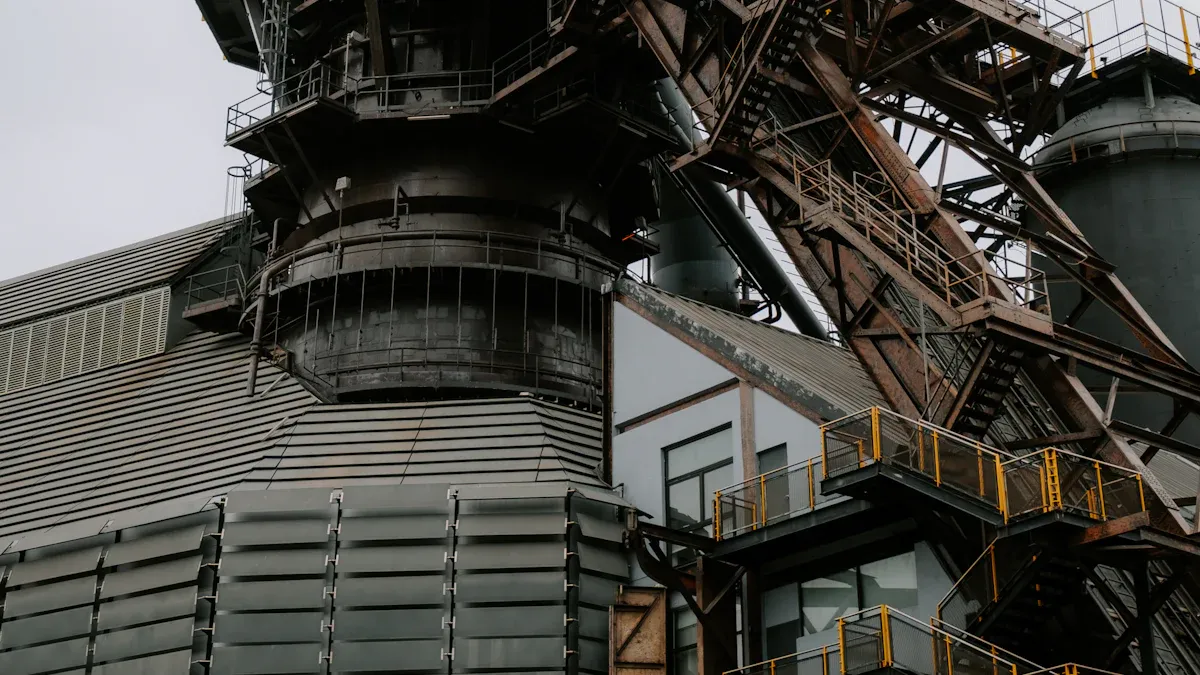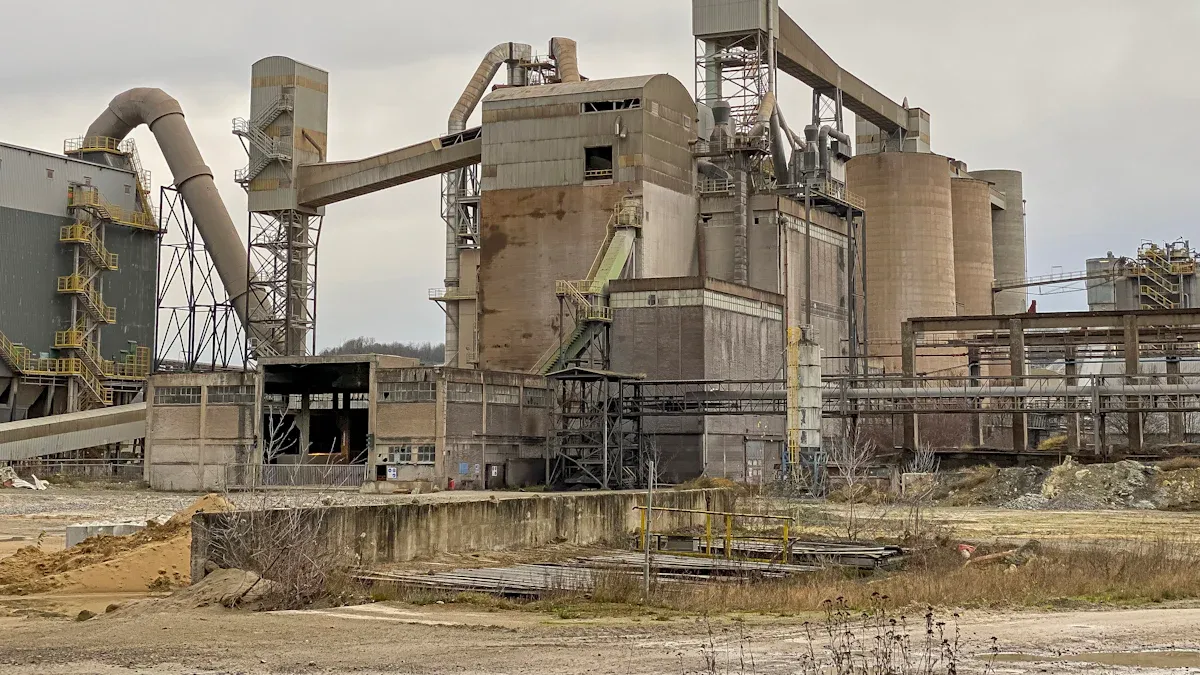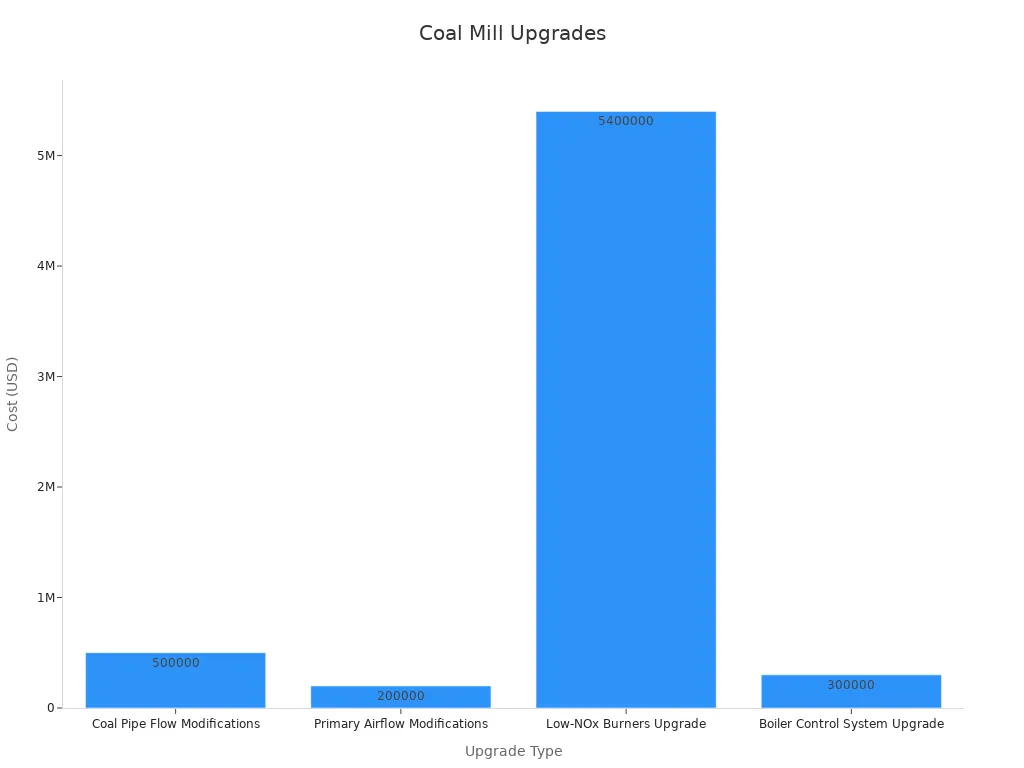
Coal mills play a vital role in cement production. They transform raw coal into fine particles, making it a reliable fuel for the high-temperature kilns used in the process. Without efficient grinding, the entire cement-making operation co uld face interruptions.
You might wonder how coal mill components contribute to this efficiency. Each part works to maximize grinding performance and energy transf er. For instance:
Modern vertical roller mills reduce energy use by up to 30% compa red to older ball mills.
Pre-drying systems and anti-blocking devices improve output by 15% when processing moist coal.
Vibration anti-blocking devices cut downtime by 30%, reducing wear part replacements by 20%.
These innovations ensure consistent fuel quality, which is essential for producing high-grade cement while keeping c osts manageable.
Coal serves as a critical energy source in cement manufacturing. It provides the heat required to reach the high temperatures necessary for clinker production in kilns. Without coal, achieving the desired chemical reactions in the kiln would be impossible. You might not realize it, but coal also contributes to the physical properties of cement. For example, coal fly ash, a byproduct of coal combustion, is often used as a secondary material in cement. This practice enhances the strength and durability of the final product.< /p>
Globally, coal fly ash generation has remained steady at approximately 0.35 billion tons per year since 2010. However, its use in cement production has decreased over time. In 2002, secondary materials like coal fly ash made up 25% of cement production. By 2018, this figure dropped to 17%, even as global cement production more than doubled from 1.80 billion tons to 4.05 billion tons. These numbers highlight coal's evolving role in the industry.
Coal mills transform raw coal into fine particles suitable for combustion. This process involves grinding and drying the coal to ensure it burns efficiently in the kiln. Modern vertical coal mills excel at this task. They grind and dry coal simultaneously, reducing energy consumption and improving fuel qua lity.
A cement plant recently optimized its coal mill performance, cutting coal and energy usage by 2%. This change saved up to $330,000 annually while reducing CO2 and NOx emissions. Such improvements de monstrate how coal mills contribute to both economic and environmental goals.
| Aspect | Details |
|---|---|
| Market Focus | Vertical coal mills in cement production and coal-fired power generation. |
| Role | Grinding and drying coal for efficient combustion. |
| Importance | Ensures fuel quality and combu stion stability. |
| Influencing Factors | Technological advancements and environmental regulations. |
By ensuring consistent fuel quality, coal mills play a vital role in maintaining kiln efficiency and cement quality. Their performance directly impacts production costs an d environmental compliance.

The raw coal feeder plays a critical role in the operation of a pulverizer coal mill. It regulates the flow of raw coal into the mill, ensuring a consistent supply for grinding. Without this component, the pulverizer cannot maintain stea dy performance, leading to inefficiencies in fuel preparation.
Modern raw coal feeders are designed to handle varying coal qualities and moisture levels. They use advanced technologies like AI-based systems to adjust coal flow in real time. For example, AI-optimized feeders have improved boiler efficiency by 6% at facilities like the Gladstone Power Station. These feeders also help meet stringent emission standards by maintaining precise fuel-to-air ratios , reducing harmful emissions.
However, manufacturing raw coal feeders has become more expensive due to rising material and energy costs. Between 2021 and 2023, the price of cold-rolled stainless steel, a key material for corrosion-resistant feeders, increased by 28%. This rise, coupled with higher industrial power prices, has added €18,000–€25,000 to the operational costs of feeder manufacturers. Despite these challenges, the efficiency gains provided by modern feeders make them indispensab le in coal mill systems.
< tr>< tr>
| Key Featu re | Benefit |
|---|---|
| AI-bas ed adjustments | Improves efficienc y and reduces emissions. |
| Corrosion-resistant design | Enhances durability and reduces maintenance costs. |
| Precision control | Ensures consistent coal flow for optimal grinding performance. |
Grinding rollers and grinding rings are the heart of any pulverizer coal mill. These components work together to crush raw coal into fine particles, ensuring it meets the required size for combustion. The grinding roller applies pressure to the coal, while the grinding ring provides the surface against which the coal is ground.
Proper alignment and maintenance of these components are essential for optimal performance. For instance, an MPS mill requires at least 20 tons of force on the grinding tires to achieve efficient grinding. Misaligned rollers or w orn-out rings can lead to poor fuel fineness, reducing the efficiency of the kiln. Additionally, the pulverizer throat clearance must be set correctly to avoid excessive coal rejects and ensure smooth airflow.
High-quality grinding elements not only improve performance but also extend the lifespan of the coal mill. Advanced pressure devices optimize the grinding force, enhancing efficiency and reducing wear. Speed reducers, another critical component, control the rotational speed of the grinding rollers, ensuring consistent output. These innovations make grinding rollers and rings vital for maintaining the productivity of a pulverizer coal mill.
Key Functions of Grinding Rollers and Rings:
Crush coal into fine particles for efficient combustion.
Maintain consistent particle size to ensure stable kiln operation.
Reduce wear and tear through advanced pressure regulation.
Hot air fans are essential for drying coal during the grinding process. They blow heated air into the pulverizer, removing moisture from the raw coal and improving its combustibility. Without these fans, the co al would retain moisture, leading to incomplete combustion and reduced kiln efficiency.
Modern hot air fans are designed to handle high temperatures and operate continuously under demanding conditions. They ensure that the pulverizer coal mill operates efficiently, even when processing coal with high moisture content. By maintaining the right airflow, these fans also prevent blockages in the mill, reducing downtime and maintenance costs.
In addition to drying coal, hot air fans play a role in controlling the temperature inside the mill. This helps prevent overheating, which can damage other coal mill components. By ensuring a stable operating environment, hot air fans contribute to the overall efficiency and reliability of the coal mill system.
Benefits of Hot Air Fans:
Enhance coal drying for better combustion.
Prevent blockages and reduce maintenance needs.
Maintain optimal mill temperature for consistent performance.
The combustion chamber in a coal mill is where the magic of energy conversion happens. It burns the finely ground coal, releasing the heat needed to power the cement kiln. Without this component, the entire process would come to a halt. You c an think of it as the heart of the system, pumping energy into the production line.
Modern combustion chambers are designed to handle different types of coal, from anthracite to lignite. They operate under high pressure and temperature conditions to ensure complete combustion. This efficiency minimizes fuel waste and reduces harmful emissions. For example, anthracite coal can reach a maximum pressure of 1.764 MPa and a temperature of 1600.55°C in the chamber. These conditions ensure optimal energy transfer to the kiln.
| Coal Type | Max Pressure (MPa) | Pressure Increase (%) | Max Temperature (°C) | Temperature Increase (%) |
|---|---|---|---|---|
| Anthracite | 1.764 | 10.32 | 1600.55 | 2.85 |
| Bituminous | 1.620 | 8.66 | 1476.55 | 3.63 |
| Lignite | 1.567 | 7.11 | 1425.05 | 5.62 |
| Subbituminous | 1.405 | 8.84 | 1215.25 | 3.07 |
You might wonder how these chambers maintain such extreme conditions. Advanced materials and engineering techniques make this possible. Heat-resistant alloys and ceramic linings protect the chamber walls from damage. Additionally, precise airflow control ensures that the coal burns evenly, maximizing energy output.
By maintaining high efficiency, combustion chambers not only improve kiln performance but also lower production costs. They reduce the amount of coal needed, which directly impacts your bottom line. Moreover, modern designs help meet strict environmental regulations by cutting down on pollutants like CO2 and NOx.
Hydraulic systems in coal mills play a crucial role in maintaining operational stability. They control the grinding pressure applied by the rollers, ensuring consistent coal particle size. Without these systems, the grinding process would become erratic, leading to inefficiencies and potential equipment damage.
You can think of the hydraulic system as the muscle of the coal mill. It applies the force needed to crush the coal into fine particles. Modern hydraulic systems use advanced sensors and actuators to adjust pressure in real time. This adaptability allows the mill to handle varying coal qualities and moisture levels without compromis ing performance.
One of the key benefits of hydraulic systems is their ability to reduce wear and tear on grinding components. By maintaining optimal pressure, they prevent excessive force that could damage the rollers and rings. This extends the lifespan of these critical parts, saving you money on maintenance and replacements.
Another advantage is the system's contribution to energy efficiency. By optimizing the grinding process, hydraulic systems reduce the power required to operate the mill. This not only lowers energy costs but also minimizes the environmental impact of cement production.
Key F eatures of Hydraulic Systems:
Real-time pressure adjustments for consistent grinding.
Reduced wear on grinding components, lowering maintenance costs.
Enhanced energy efficiency, cutting operational expenses.
In addition to these benefits, hydraulic systems improve safety. They include fail-safe mechanisms that prevent overpressure conditions, protecting both the equipment and the operators. This reliability makes them an indispensable part of modern coal mills.
Tip: Regular maintenance of hydraulic systems can further enhance their performance. Check for leaks, monitor pressure levels, and replace worn-out components promptly to avoid unexpected downtime.
By integrating advanced hydraulic systems, you can achieve a more stable and efficient coal milling process. This not only boosts productivity but also ensures the long-term reliability of your equipment.
Coal grinding involves multiple components worki ng in harmony to ensure efficient energy transfer. The process begins when raw coal enters the pulverizer through the raw coal feeder. Inside, grinding rollers and rings crush the coal into fine particles. This pulverized coal is then dried using hot air fans, which blow heated air into the mill. The drying process ensures the coal burns efficiently in the combustion chamber.
Once the pulverized coal reaches the combustion chamber, it burns to release heat energy. This energy powers the cement kiln, enabling it to reach the high temperatures required for clinker production. The hydraulic system plays a crucial role by maintaining consistent grinding pressure, ensuring the coal particles are fine enough for optimal combustion. Together, these components create a seamless process that maximizes energy transfer and minimizes wast e.
| Section | Description |
|---|---|
| Preparation Section | Coal is ground with water to form slurry for IGCC plants or dried with hot flue gases for Shell-based IGCC plants. |
| Gasification Section | Slurry feed is pumped to the gasifier where coal is gasified with oxygen to generate syngas. Heat liquefies coal ashes, which are then quenched and crushed. The process includes two stages for different reactions in GE and E-Gas™ systems. |
Consistent particle size is essential for efficient combustion. The grinding rollers and rings in the pulverizer ensure the coal is ground to the required fineness. If the particles are too larg e, they may not burn completely, reducing energy efficiency. On the other hand, overly fine particles can lead to excessive wear on the mill components.
The hydraulic system helps maintain the correct grinding pressure, ensuring uniform particle size. Hot air fans also contribute by removing moisture from the pulverized coal, preventing clumping and ensuring smooth airflow. This consistency improves combustion stab ility in the kiln, leading to better cement quality and reduced emissions.
Raw coal is fed into the pulverizer thro ugh the raw coal feeder.
The coal is pulverized between the roller an d the ring.
The pulverized coal is bl own into the combustion chamber by the primary air fan.
Hot gases p roduced from burning the coal powder dry the pulverized coal and transport it to the boiler.
Heat energy from burning coal passes through heat exchangers to produce steam, which drives turbines for electricity.
Efficient coal mill operation reduces waste and enhances productivity. By integrating advanced hydraulic systems, you can optimize grinding pressure, reducing wear on components like grinding rollers and rings. This extends their lifespan and lowers maintenance costs. Hot air fans also play a role by preventing blockages, which minimizes downtime.
Modern combustion chambers ensure complete combustion of pulverized coal, reducing unburned residues. This not only improves energy efficiency but also cuts down on harmful emissions. Together, these components create a streamlined process that maximizes output while minimizing waste, helping you achieve both economic and environmental goals.
Tip: Regular maintenance of coal mill components can further enhance efficiency. Inspect grinding elements, clean hot air fans, and monitor hydraulic systems to avoid unexpected issues.

The efficiency of coal mills directly impacts the quality and consistency of cement. Pulverized coal with high moisture content can disrupt kiln operations, leading to irregularities in clinker production. You might notice that when coal retains excess moisture, it burns unevenly, causing temperature fluctuations in the kiln. These fluctuations affect the chemical reactions required for producing high-quality cement.
Several factors contribute to maintaining cement consistency. For instance:
- High free moisture c
ontent in coal can cause irregularities in coal mill operation, affecting kiln efficiency.
- The Hardgrove test shows that moisture levels significantly reduce coal grinding effectiveness, impacting cement production.
- Monitoring pulverized coal quality ensures optimal combustion and high thermal efficiency during clinker production.
Real-time moisture detection systems can help you address these challenges. By adjusting operations immediately, you can stabilize kiln performance and enhance energy efficiency. This approach ensures that the final cement product meets the required standards for stre ngth and durability.
Coal mill efficiency plays a crucial role in controlling production costs and energy consumption. Efficient grinding reduces the amount of coal required for combustion, directly lowering fuel expenses. For example, modern coal pulverizers optimize the grinding process, ensuring minimal energy waste. This not only saves money but also supports sustainable power generation practices.
You can achieve significant cost savings by addressing inefficiencies in coal mill systems. Advanced technologies like AI-based monitoring systems help optimize material usage, reducing resource consumption. Additionally, stabilizing kiln operations through moisture c ontrol minimizes energy losses. These improvements translate into lower operational costs and reduced environmental impact.
Consider this:
- AI systems optimize material usage, maintaining consistency in the final product.
- Stabilizing kiln operations through moisture control enhances energy efficiency.
- Efficient combustion of pulverized coal reduces unburned residues, cutting waste.
By focusing on these areas, you can achieve a balance between cost-effectiveness and environmental responsibility.
Regular maintenance and m odernization of coal mill systems are essential for long-term efficiency. Neglecting these aspects can lead to equipment failures, increased downtime, and higher operational costs. Upgrading outdated components ensures that your coal mill operates at peak performance, supporting consistent cement production.
Modernization efforts often involve significant investments, but the benefits outweigh the costs. For example:
| Upgrade Type | Cost Estimate | Benefits |
|---|---|---|
| Coal Pipe Flow Modifications | $500,000 | Ensures equal coal flow to burners, improving air-to-fu el ratios. |
| Primary Airflow Modifications | $200,000 | Enhances efficiency by addressing pressure drop is sues. |
| Low-NOx Burners Upgrade | $5,400,000 | Reduces NOx emissions, improves combustion, and enhances boiler performance. |
| Boiler Control System Upgrade | $300,000 | Increases boiler efficiency and reduces fan power consumption. |
| Total Estimated Cost | $6,400,000 | Comprehensive upgrades lead to significant operational savings and efficiency improvements. |

Upgrades like these improve combustion efficiency, reduce emissions, and extend the lifespan of your equipment. Regular maintenance also plays a vital role. By inspecting grinding elements, cleaning hot air fans, and monitoring hydraulic systems, you can prevent unexpected issues and e nsure smooth operations.
Tip: Schedule routine maintenance checks to identify potential problems early. This proactive approach minimizes downtime and maximizes productivity.
Investing in maintenance and m odernization not only enhances coal mill efficiency but also supports sustainable cement production. These efforts help you stay competitive in a rapidly evolving industry.
Coal mill components are the backbone of efficient cement production. Each part, from grinding rollers to hydraulic systems, plays a role in ensuring consistent fuel preparation and energy transfer. Without them, maintaining kiln stability and cement quality becomes nearly impossible.
To optimize operations, you must focus on key parameters:
- Keep mill hot air inlet temperatures below 315°C and outlet temperatures under 90°C to avoid hazards.
- Ensure duct velocities exceed 25 m/s to prevent material buildup and fire risks.
- Control kiln feed rates for steady energy needs
and proper clinker formation.
Efficient coal mill operation not only enhances cement quality but also reduces costs and environmental impact. By prioritizing maintenance and modernization, you can achieve long-term success in cement manufacturing.
A coal mill grinds raw coal into fine particles, making it suitable for combustion in cement kilns. This process ensures the kiln reaches the high temperatures needed for clinker production. Efficient coal mills improve fuel quality and reduce energy consumption.
Medium-speed coal mills, like the bowl-type medium-speed mill, balance efficiency and capacity. They operate at moderate speeds, grinding coal effectively while consuming less energy. In contrast, low-speed coal mills handle larger coal chunks, and high-speed coal mills focus on finer grinding.
Consistent coal particle size ensures efficient combustion in the pulverized coal burner. Uniform particles burn evenly, providing stable heat for the kiln. Irregular sizes can cause incomplete combust ion, reducing efficiency and increasing waste.
A pulverized coal separator ensures only fine coal particles reach the pulverized coal silo. It separates oversized particles, sending them back for regrinding. This process improves combustion efficiency and reduces emissions.
Coal mills supply finely ground coal to large capacity coal-fired boilers. This ensures efficient combustion, maximizing energy output. Properly functioning mills reduce fuel waste and support stable boiler operations.